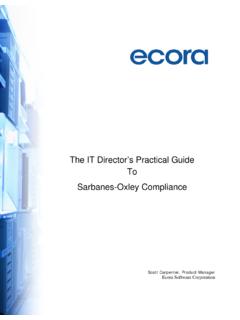Transcription of Practical Guide to the Systematic Use of …
1 Practical Guide to the Systematic Use of standards & INDICATORS. in UNHCR Operations FEBRUARY 2006 / SECOND EDITION. Practical Guide to the Systematic Use of standards & INDICATORS. in UNHCR Operations Prepared by: Division of Operational Services UNHCR Geneva With special thanks to: Jean Bosco Rushatsi (PCOS), Camillo Boano, Bela Hovy (FICSS) & Pablo Lattes. Second Edition i Copyright United Nations High Commissioner for Refugees (UNHCR). Second edition February 2006. ii Foreword It is with pleasure that I present the second edition of the Practical Guide to the Systematic Use of standards and Indicators in UNHCR Operations. For the last fourteen months, UNHCR.
2 Has undertaken consultations, both at Headquarters and in the Field, in order to produce an updated version of the Practical Guide which provides guidance on the definitions, rationale, concepts and sources of data for a range of standards and indicators, which will be used to gain a picture of the well-being of girls, boys, women and men of concern to UNHCR and who are being assisted under various types of operations. The Systematic gathering of information on people of concern to UNHCR, their needs, gaps in assistance and protection and resources is still required to bring programmes up to acceptable standards and forms therefore a key precondition for the effective design of opera- tional strategies, programmes and projects, and advocacy for resource mobilization.
3 This second edition should be considered as another step in the work-in-progress to- wards consolidating UNHCR's long-term vision of establishing and systematically using a set of agreed standards and indicators for planning and measuring the impact of its operations. The revision process included considerable efforts to come up with measurable indicators for different relevant areas and set the basis for further refinement. In addition to the camp- based refugee situations, the Guide now incorporates newly developed sets of standards and indicators for urban as well as for reintegration operations. It also provides chapters with newly adopted methodologies on age, gender and diversity mainstreaming, situation analysis and new reporting requirements.
4 As noted, performance indicators for the full range of UNHCR's activities are being progres- sively developed. This will be an integral facet of UNHCR's further adoption of Results-Based Management methodologies. As mentioned, for the second edition of this work (February 2006), priority was given to new indicators for urban programmes and returnee operations. It is planned that the subsequent edition will address issues related to other types of durable solutions enhancing protection (inter alia through advocacy and public information), and activities dealing with internally displaced persons (IDPs). I believe that this second edition of the Guide will prove useful to all UNHCR operations and implementing partners by strengthening capacity to carrying out our mandatory respon- sibility to protect and assist our people of concern.
5 Most important, it provides a sound basis for assessing our work and mapping the distance still to be travelled in order to ensure better quality in the protection and assistance that we provide. Arnauld Akodjenou Director, Division of Operational Services Practical Guide iii iv Table of Contents Foreword Table of Contents Introduction Structure of the Guide Part A Conceptual Background Introduction UNHCR standards and Indicators Background Basic Principles - International Human Rights, Refugee Law and UNHCR Mandate - Framework for Durable Solutions Relevant External Initiatives - The Millennium Development Goals (MDGs). - The Sphere Project UNHCR Approaches and Internal Guidelines - Rights-based approach - Age, gender and diversity mainstreaming - Participatory assessment and planning - Project Profile and registration - Urban refugee policy development - Community based approach The RBM and UNHCR's Operations Management System standards and Indicators Definitions Part B standards , Indicators and UNHCR's Operations Management System Introduction standards , Indicators and Planning - UNHCR Operations Planning Cycle - Assessment and data collection - Participatory Assessment Practical Guide v - standards .
6 Indicators and Gap Analysis - Country Operations Plan - Project Submission and Sub-Project Agreement - Resource allocation - Implementation and Coordination Monitoring, Reporting and Evaluation - Monitoring - Reporting - Evaluation Operations Data Collection and Management - Definitions - Data types and levels - Data sources - Data collection methods - Reporting and presentig data - Data collection and management strategy - Tools and capacity building Part C Standard and indicator Guidelines Introduction Indicators: Selection and Rationale - Areas of reference and UNHCR situations standards and Indicators Report (SIR) Instructions - General data and demography - Themes and sub-themes The indicator Summary Boxes Country Level - indicator Summary Boxes Urban Programme - indicator Summary Boxes Refugee Camp/Settlement - indicator Summary Boxes Returnee Area - indicator Summary Boxes Acronyms Glossary Bibliography ANNEX 1 (SIR).
7 Vi Practical Guide . Introduction Since the mid-1990s, humanitarian agencies have become increasingly aware of the importance of improving outcomes of programmatic activities through monitoring and enhancing institu- tional accountability. At a global level, various initiatives between humanitarian organizations, agencies and donors have resulted in much important work in developing performance standards and indicators relating to their respective contributions to humanitarian Among others, the Executive Committee for Humanitarian Affairs (ECHA)/Inter-Agency Stand- ing Committee (IASC) recently launched an independent Humanitarian Response Review (HRR) of the global humanitarian system (UN, NGOs, Red Cross/Red Crescent Movement and International Organization for Migration [IOM]), to map the gaps, and to make recommendations to address them.
8 The review recommends the establishment and application of different sets of benchmarks at the level of the organizations (management benchmarks for preparedness and planning) and of the system (process and impact benchmarks for CAP and other planning/. appeal models). UNHCR is committed to the delivery of quality protection and assistance activities and to the optimal use of limited resources; hence it has developed over the years a range of tools to enhance its programming and accountability. UNHCR has made great efforts in mainstream- ing standards and Indicators in the context of Results-Based Management within the organization. Most recently, UNHCR has invested the necessary resources in a range of consultations, both at Headquarters and in the Field, to produce this second edition of the Practical Guide to the Systematic Use of standards and Indicators in UNHCR Operations.
9 This Guide not only up- dates the previous edition and incorporates improvements to the standards and Indicators Initiative (S&I Initiative) made in 2003 and 2004, but extends further the scope of activities covered. Even with these improvements, the set of standards and indicators included in this Guide is not exhaustive. Nevertheless, it will provide enhanced quantifiable data for an increased number of situations, illustrating the well-being of the population of concern, and also allow global comparisons between UNHCR operations. Thus, through the use of indicators in this Guide , UNHCR has a monitoring tool covering UNHCR operations worldwide. The snapshot of the wellbeing of refugees and returnees which these quantitative indicators give will need to be complemented with additional information from qualitative indicators, project-level indicators, detailed sectoral data, and various narrative reports.
10 1. These include, among others, the Sphere Project, the Good Humanitarian Donorship, the Active Learning Network for Accountability and Perform- ance in Humanitarian Action (ALNAP), and Humanitarian Accountability Project, SMART. Practical Guide vii This Guide has been developed to serve as a Practical manual and reference tool for UNHCR. staff and managers in the Field, as well as for implementing and operational partners involved in needs, resource and programme assessment, planning, design, monitoring, management and evaluation. It may also prove useful for UNHCR staff and decision makers at various levels who review and coordinate operations. The Guide will also be of interest to donors and govern- ments, members of UNHCR's Executive Committee and other parties within the humanitarian community that support and monitor the activities of UNHCR in carrying out its mandate.














